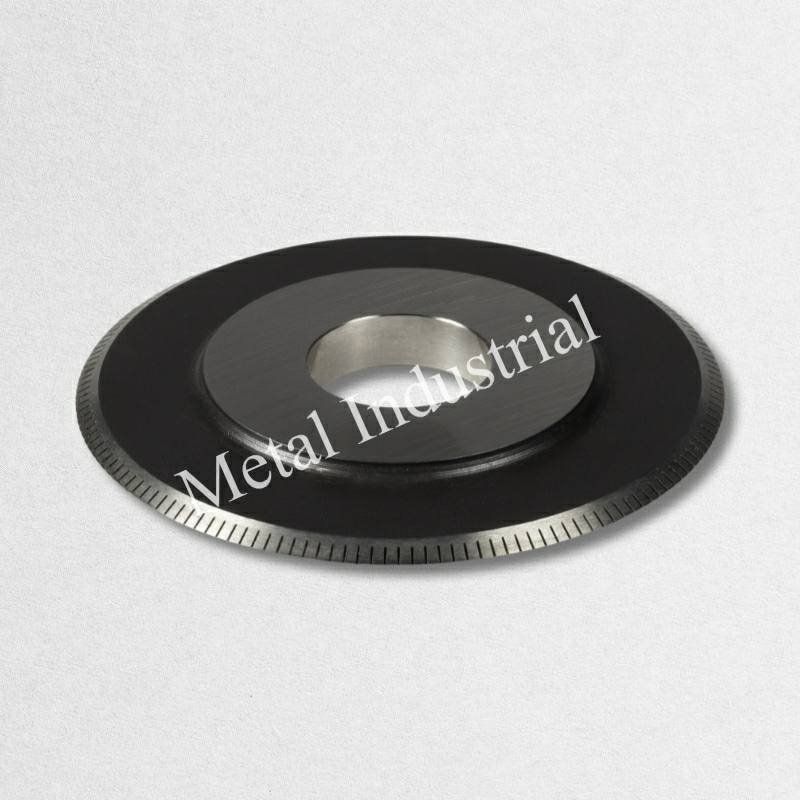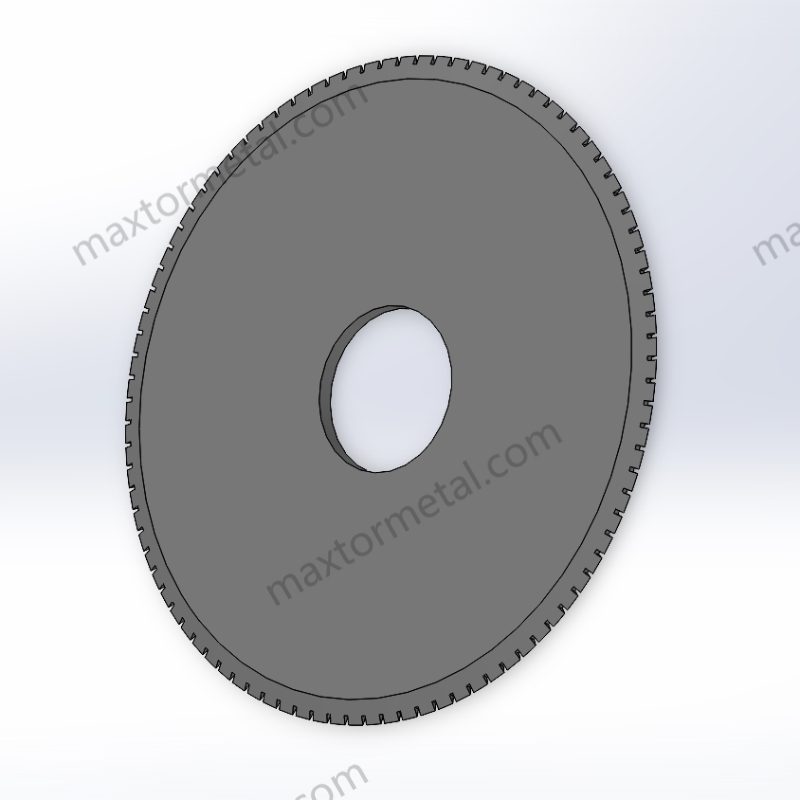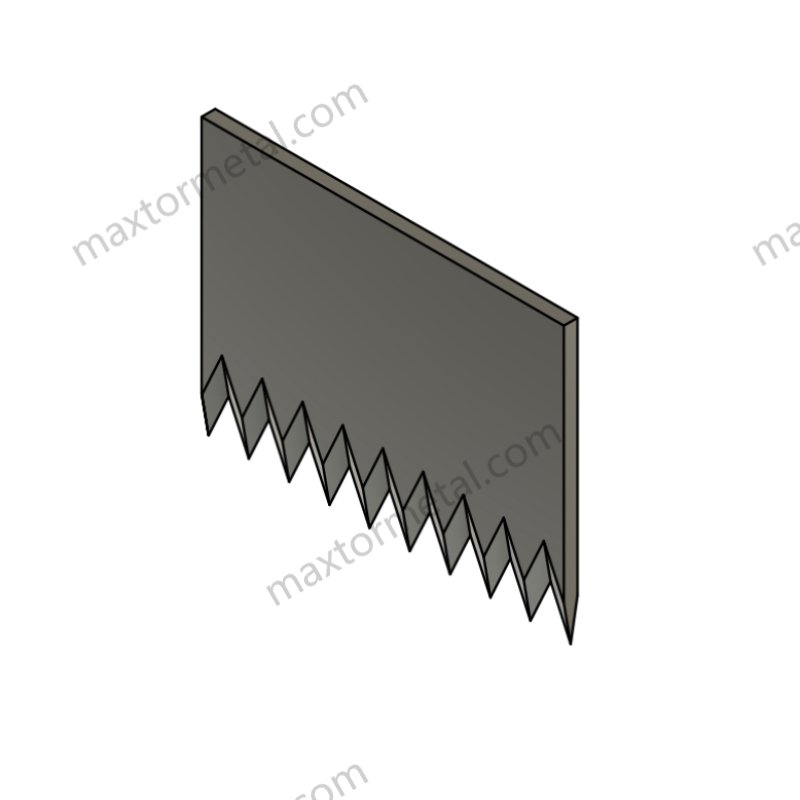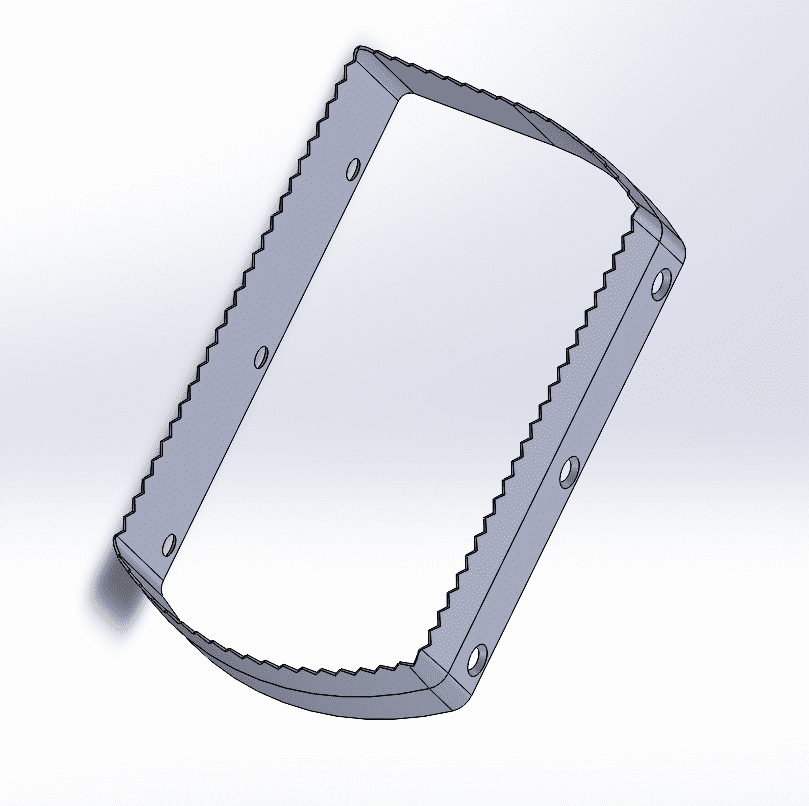
सही का चयन perforating knives from नानजिंग Metal for your job can make or break your production line. Every material behaves differently when cut, so selecting a custom blade that matches its properties is essential. For instance, studies show that altering blade shapes, such as pitch length and corner radius, affects how polypropylene sheets bend and fold. Using the wrong knife might result in weak creases or even damage your materials. Refer to the table below to see how selecting the right knife material impacts performance and efficiency:
| सामग्री का प्रकार | Benefits in Use |
|---|---|
| टंगस्टन कार्बाइड | Lasts long, handles tough materials, boosts speed |
| स्टेनलेस स्टील | Resists rust, works well in packaging and food |
| चीनी मिट्टी | Stays sharp, safe for specialty uses |
| औजारों का स्टील | Strong, ideal for custom blade needs |
| लेपित ब्लेड | Runs longer, cuts down on downtime |
When you choose perforating knives from Nanjing Metal tailored to your materials, you save time, reduce waste, and keep your machines running at peak performance. For more information or to discuss your specific needs, please संपर्क Nanjing Metal directly.
चाबी छीनना
- Choose a perforating knife that matches your material’s type, thickness, and toughness to get clean cuts and avoid damage.
- Select blade materials like carbide for tough jobs, stainless steel for wet or food-related uses, and tool steel for general cutting needs.
- Consider production speed and use coated blades or special treatments to keep blades sharp and reduce downtime.
- Test sample cuts and adjust knife settings before full production to improve cutting quality and reduce maintenance.
- Custom blades tailored to your machine and material can save time, lower costs, and boost cutting performance.
सामग्री
Common Industrial Materials
When you look at industrial cutting, you see a huge range of materials. Each one acts differently when you use a perforating knife. Some of the most common materials you’ll work with include:
- कागज़: Thin, flexible, and easy to tear. You find it in packaging, labels, and tickets.
- Plastic films: These materials are strong and flexible. They show up in food packaging, medical packaging, and flexible pouches.
- 1टीपी1टीएस: Thin sheets of aluminum or steel are used for special packaging or air vents.
- Cardboard: Thicker and tougher than paper. You see it in boxes and heavy-duty packaging material.
- Laminates and composites: These combine several materials for extra strength or special features.
Each material needs a different approach. For example, paper cuts easily, but plastic films need more precision. Metals require a tougher blade. If you use the wrong knife, you might get rough edges or even damage your materials.
Tip: Always match your knife to the material. This keeps your cuts clean and your machines running smoothly.
Application Fields
You’ll find perforating knives in many industries. Here are some of the top applications:
- पैकेजिंग: Food, medical, and consumer goods all use perforated blades for easy-open features or ventilation.
- Paper products: Think of notepads, tickets, and coupons.
- Air vents: Thin metal sheets get perforated for airflow in appliances and vehicles.
- Consumer goods: Items like wipes, tissues, and disposable products need precise cutting.
| ब्लेड सामग्री | सर्वश्रेष्ठ के लिए | विशिष्ट अनुप्रयोग |
|---|---|---|
| उच्च गति स्टील | Balanced cutting, good for paper/plastics | कागज, पतली प्लास्टिक |
| स्टेनलेस स्टील | Corrosion resistance, hygiene | Food packaging, medical |
| टंगस्टन कार्बाइड | Hard, long-lasting, tough materials | Cardboard, high-volume jobs |
| चीनी मिट्टी | Sharp, specialty uses | Harsh environments |
You’ll notice that packaging uses a lot of different materials. The right blade keeps your packaging material strong but easy to open. In perforated blade applications, you want a knife that matches both the material and the job. This helps you get the best results every time.
Perforating Knives Overview

Types of Perforating Knives
When you look at perforating knives, you’ll notice several main types. Each one works best for certain cutting jobs and materials. The most common are toothed blades, rotary knives, flat blades, and custom shapes. Toothed blades have sharp points that make small holes in a line. Rotary knives spin as they cut, which helps when you need fast or long cuts. Flat blades work well for straight, simple lines. Custom perforated industrial blades can match any special shape or size you need. You might also see circular perforating blades in many machines. These blades roll over the material, making even, clean holes.
काम के सिद्धांत
Perforating knives work by pressing or rolling against your material. The blade’s teeth or edge push through, creating a row of small holes or slits. This makes it easy to tear or fold the material later. Cutting with perforated industrial blades is all about control. You want the holes to be just right—not too deep or too shallow. Circular perforating blades help you get smooth, repeatable results, especially in high-speed applications. The right knife keeps your cutting process steady and your products looking sharp.
Note: The way you set up your perforated industrial machine knives can change how well they cut. Always check the blade’s angle and pressure for the best results.
Perforated Industrial Machine Knives
You’ll find perforated industrial machine knives in many industries. They show up in packaging, food processing, medical supplies, and more. These blades handle everything from thin films to thick cardboard. Tool steel, carbide, ceramic, and stainless steel are the most common materials for these knives. Each one offers different strengths for cutting. For example, carbide blades last a long time in tough applications. Stainless steel resists rust in wet environments. Circular perforating blades are popular for their speed and accuracy. When you choose the right perforated industrial blades, you make your cutting jobs easier and your products better.
Choosing the Right Knife Material

When you start choosing the right knife material, you set the stage for better cutting performance and longer blade durability. The material you pick for your blade decides how well it handles tough jobs, how long it lasts, and how clean your cuts look. Not all industrial knife materials work the same way. Some give you more durability, while others focus on speed or resistance to rust.
Key Materials for Blades
औजारों का स्टील
Tool steel stands out for its toughness and ability to keep a sharp edge. You can use it for cutting paper, cardboard, and even some plastics. It handles heat well, so you get steady performance during long runs. Tool steel gives you a good balance between cutting performance and blade durability.
करबैड
Carbide blades bring exceptional hardness and wear resistance. If you need to cut abrasive or thick materials, carbide is a top choice. These blades stay sharp for a long time, even at high speeds. Carbide works best when you want maximum durability and top cutting performance.
चीनी मिट्टी
Ceramic blades offer high hardness and excellent heat stability. They do not conduct heat much, so they stay cool during fast cutting. You can use ceramic for specialty jobs where you want less friction and smoother cuts. Ceramic blades also help reduce cutting forces, which means less wear on your machines.
स्टेनलेस स्टील
Stainless steel blades shine in wet or food-related environments. They resist rust and corrosion, making them perfect for packaging and medical cutting. While they may not match tool steel or carbide for wear resistance, they give you reliable performance and easy cleaning.
Here’s a quick look at how these materials compare:
| सामग्री | Hardness & Wear Resistance | Heat Resistance & Edge Retention | जंग प्रतिरोध | Typical Industrial Use & Notes |
|---|---|---|---|---|
| औजारों का स्टील | High hardness, abrasion resistance, deformation resistance | Good edge retention at elevated temperatures | मध्यम | Well-suited for tools requiring toughness and edge retention under heat. |
| करबैड | असाधारण कठोरता और पहनने के प्रतिरोध | High-temperature strength, enhanced by coatings | Low corrosion resistance | Dominant in metalworking; coatings improve toughness and wear resistance. |
| चीनी मिट्टी | High hardness, competitive with coated carbide | Excellent high-temperature stability, low heat conductivity | Low corrosion resistance | Reduces cutting forces and heat generation; great for specialty cutting. |
| स्टेनलेस स्टील | Lower wear resistance compared to tool steel and carbide | Moderate heat resistance | High corrosion resistance | Iron-based alloy with chromium to prevent rusting; best for food and medical cutting. |
Matching Knife Material to Application
You want to match your blade to the material you plan to cut. For thick or abrasive materials, carbide or ceramic gives you the best durability and cutting performance. If you work with food or medical products, stainless steel is your go-to for safety and corrosion resistance. Tool steel fits well for general cutting jobs that need a tough, reliable edge.
Common Blade Coatings and Treatments
Sometimes, you need even more durability or better cutting performance. Coatings like titanium aluminum nitride (TiAlN) or titanium carbonitride (TiCN) boost carbide blades, letting them handle higher temperatures and tougher jobs. These coatings cut down on friction and heat, so your blades last longer and keep their edge. You can also find treatments that make tool steel or stainless steel blades more resistant to wear and scratches.
Tip: Always think about your material, production speed, and the environment when picking your blade. The right choice keeps your cutting sharp and your machines running longer.
Key Factors in Choosing

When you pick the right perforated knife, you need to look at several key factors in choosing. These factors help you get the best cutting results and keep your production running smoothly. Let’s break down what you should check before making a decision.
Material Thickness and Density
Assessing Material Thickness
Start by measuring how thick your material is. Thicker materials need stronger, more rigid blades. Thinner materials work better with sharp, fine blades. The thickness affects how fast you can cut and how much waste you create.
| ब्लेड की मोटाई | काटने की गति (मी/मिनट) | Downtime (hours/week) | सामग्री अपशिष्ट (%) |
|---|---|---|---|
| 0.4 मिमी | 180 | 2 | 1.8 |
| 0.6 मिमी | 160 | 1.2 | 2.5 |
| 1.0 मिमी | 140 | 0.8 | 3.1 |
You can see that thinner blades cut faster but may need more maintenance. Thicker blades slow down the process but last longer.
Evaluating Material Density
Density tells you how heavy and solid your material is. High-density materials, like tungsten carbide, give you great stability and durability. However, they can be brittle, so you need to handle them carefully. Always match the blade to the density for the best cutting performance.
Impact on Knife Selection
If you use the wrong blade for your material’s thickness or density, you might get rough cuts or even damage your equipment. Integrated tests show that measuring thickness and density helps you predict how your material will react during cutting. This step is key for all perforated applications.
Perforation Strength and Tear Resistance
Required Perforation Strength
Every material has a different strength. Some need more force to perforate. For example, fiber metal laminates use special models to check how much force is needed for cutting. You want a knife that matches your material’s strength for clean, easy cuts.
Tear Resistance of the Material
Tear resistance means how well your material holds up after being perforated. If your material tears too easily, you need a gentler blade. If it is tough, you need a stronger blade. Tests like edge-crush and shear stiffness help you find the right match.
Matching Knife Design to Material Properties
You can change the knife’s tooth shape, spacing, and edge width to fit your material. This helps you get the right balance between easy tearing and strong packaging. Always test different designs to see what works best for your cutting requirements.
Production Speed and Efficiency
Influence of Production Speed on Knife Choice
High-speed cutting needs blades that stay sharp and cool. If you run your machines fast, pick blades with special coatings or treatments for better durability and performance.
Balancing Efficiency and Durability
You want to cut quickly but also keep your blades lasting a long time. Advanced treatments like titanium nitride coatings can boost durability by 300%. This means less downtime and more products made.
Adjusting Knife Parameters for High-Speed Operations
Modern manufacturing uses laser cutting and CNC grinding to make blades with exact shapes and sharpness. These methods help you get the best results, even at high speeds. Quality checks, like hardness and edge sharpness tests, make sure your blades meet your needs.
Specifying Custom Knife Dimensions
When you order custom perforated blades, give details like outer diameter (OD), inner diameter (ID), hub thickness, tooth spacing, and edge width. These details help the manufacturer make a blade that fits your applications perfectly.
Tip: Always test your blades before full production. Measure your material, define your cutting needs, and talk to a specialist. Sample testing helps you avoid mistakes and get the best cutting performance.

Custom Perforating Knives
अनुकूलन के लाभ
When you work with unique materials or special machines, standard blades often fall short. Custom-designed industrial perforation blades give you a real advantage in these situations. You can send in your drawings or even a photo, and experts will create a blade that fits your equipment perfectly. This saves you time because you do not have to search for a replacement that might not even exist.
You also save money in the long run. When you choose the right blade material for your specific applications, you get longer blade life and fewer breakdowns. This means less maintenance, fewer stops for repairs, and more time with your machines running. Strict quality checks make sure every blade meets high standards, so you do not have to worry about defective parts causing extra maintenance. If you ever need to tweak a design, you can do that too. Customization lets you improve performance for your exact needs.
Here are some key benefits you get from custom blades:
- Fast turnaround for unique equipment designs
- Expert material selection for your applications, which cuts down on maintenance
- Multiple quality checks to prevent maintenance issues
- Easy design changes to boost performance
- Over 15 years of industry experience behind every blade
You can see the difference in the numbers:
| मीट्रिक | मानक ब्लेड | कस्टम ब्लेड |
|---|---|---|
| Monthly Blade Replacements | 12 | 3 |
| Average Blade Cost | $10 | $30 |
| कुल मासिक लागत | ~$2,400 | ~$1,000 |
“We saved two days of machine time each month.”
“Our blades now pass cleanliness tests easily. Both safety and performance got better.”
नानजिंग Metal समाधान
If you want a trusted perforating knife supplier, you should know about नानजिंग Metal. This company has 18 years of experience making industrial blades for all kinds of applications. Their team knows how to design and build custom blades that fit your machines and your production goals. They focus on quality, reliability, and making sure you spend less time on maintenance.
Nanjing Metal offers a wide range of custom solutions. You can get blades for packaging, food processing, or any other industrial use. Their experts help you pick the right materials and coatings, so you get the best performance and the least maintenance. Many customers trust Nanjing Metal because they deliver blades that last longer and need less maintenance, which keeps your production line moving.
Ready to upgrade your blades or solve a tricky cutting problem? Reach out to a sales engineer through their संपर्क page and see how custom blades can improve your applications.
Mistakes and Tips

सामान्य गलतियां
When you choose a perforated knife, you might run into some common mistakes. These can hurt your cutting results and lead to more maintenance.
Selecting the Wrong Tooth Size
If you pick the wrong tooth size, your cutting will not be clean. Small teeth work better for thin materials. Large teeth suit thicker items. The wrong choice can cause rough edges or weak perforated lines. This means more maintenance and lower performance.
Choosing an Inappropriate Knife Material
Some people use a blade that does not match the material. If you use a soft blade for hard materials, you will see poor cutting and fast wear. This mistake leads to more maintenance and less durability. Always match the knife material to your job for better performance.
Using the Incorrect Knife Type
You need to pick the right type of perforated knife. Rotary knives work well for fast, long cuts. Flat knives suit straight lines. The wrong type can slow down your cutting and increase maintenance.
Overlooking Material Compatibility
If you ignore how your material reacts to the blade, you may get bad results. Some materials need special blades for clean perforated cuts. Not checking this can mean more maintenance and lower performance.
Ignoring Production Requirements
You should always think about your production speed and how often you want to stop for maintenance. If you do not, you may pick a knife that cannot keep up. This leads to more downtime and less cutting efficiency.
Practical Testing and Adjustments
You can avoid many problems by testing and making small changes.
Conducting Sample Testing
Try a sample cut before full production. This helps you see if the perforated knife gives you the right cutting and performance. You can spot maintenance issues early.
Adjusting Knife Settings and Parameters
Change the pressure, speed, or alignment of your knife. Small tweaks can boost cutting performance and reduce maintenance.
Consulting with Knife Suppliers or Experts
Talk to experts if you have trouble. They can help you pick the best perforated knife for your needs. This advice can save you time and lower maintenance.
Monitoring Performance and Making Iterative Improvements
Keep an eye on your cutting results. If you see problems, make small changes. This helps you keep high performance and less maintenance over time.
Tip: Regular checks and quick adjustments keep your perforated knives working well and reduce maintenance.
If you want expert advice or need a custom solution, you can reach out to a trusted industrial blade manufacturer. For more help, feel free to contact a sales engineer.
Choosing the right perforating blade starts with knowing your material. You check thickness, density, and how tough it is to cut. Next, you match the blade type and material to your job. Testing helps you avoid mistakes. If you want a trusted perforating knife manufacturer, Nanjing Metal brings 18 years of experience and industry recognition. Ready to get expert advice? Reach out to a sales engineer यहाँ.
सामान्य प्रश्न
What is a perforating knife used for?
You use a perforating knife to make small holes or slits in materials. This helps you tear, fold, or separate products easily. You often see these cuts in packaging, tickets, and labels.
How do I know which blade material is best for my job?
Check your material type and how tough it is. For soft items, use tool steel or stainless steel. For hard or abrasive jobs, try carbide or ceramic. If you feel unsure, test a sample first.
Can I get a custom blade for my machine?
Yes! You can order a कस्टम ब्लेड to fit your machine and material. Just share your machine details and cutting needs. Experts will help design the right blade for you.
How often should I replace my perforating blade?
Blade life depends on your material and how much you use it. If you notice rough cuts or more effort needed, it’s time to change the blade. Regular checks help you avoid problems.
What should I do if my blade keeps wearing out fast?
Try using a harder blade material or add a special coating. Make sure your machine settings match your material. If you still have trouble, ask a blade expert for advice.
Want more help or a custom solution? Reach out to a sales engineer यहाँ.
यह भी देखें
छिद्रण ब्लेड क्या हैं और उनका उपयोग कैसे किया जाता है
बैगर चाकू के लिए अंतिम गाइड: पैकेजिंग उद्योग के लिए प्रकार, अनुप्रयोग और रखरखाव युक्तियाँ
अपनी ज़रूरतों के लिए सही औद्योगिक पेपर कटिंग चाकू कैसे खोजें



5 प्रतिक्रियाएं